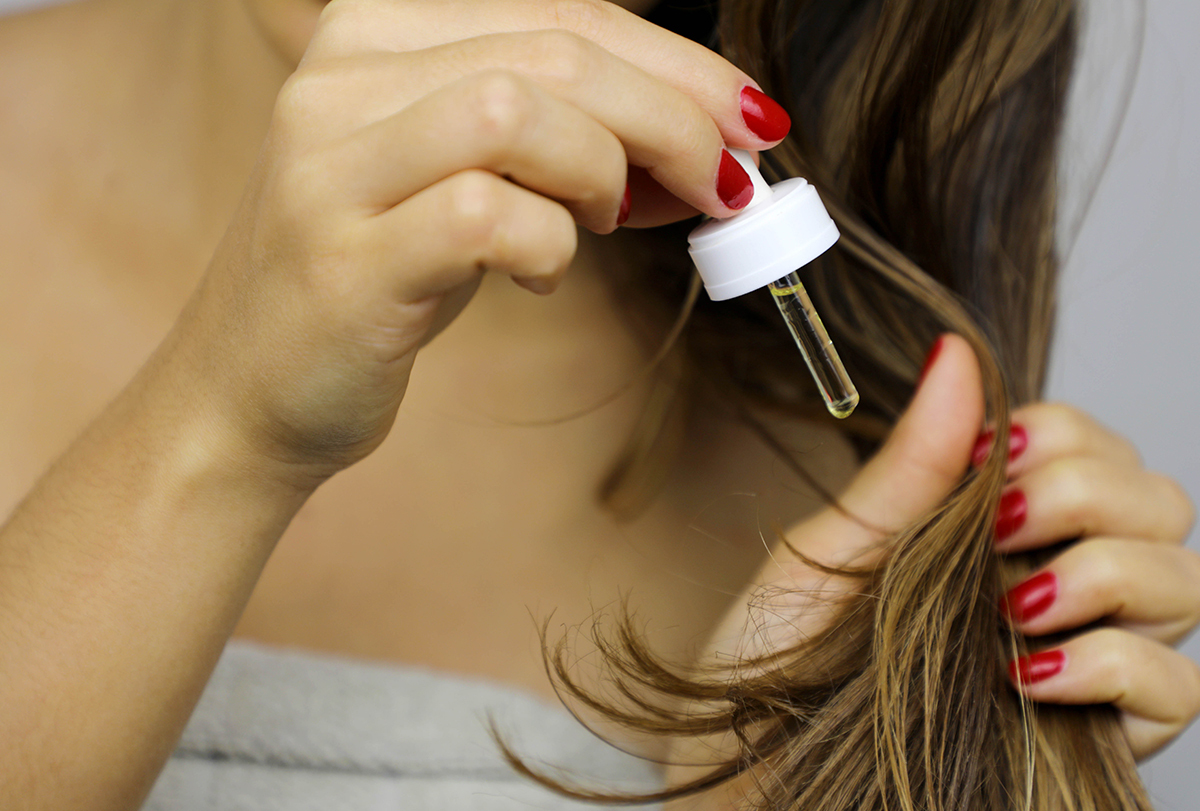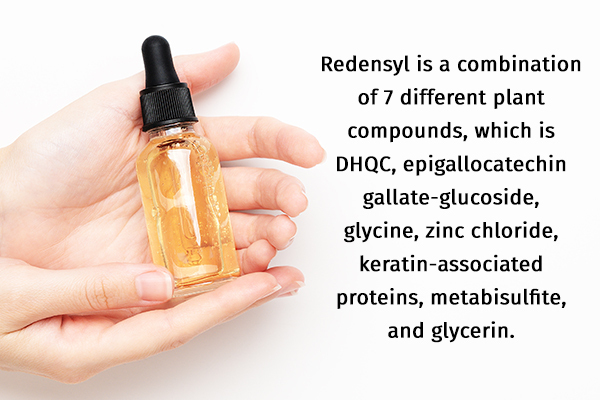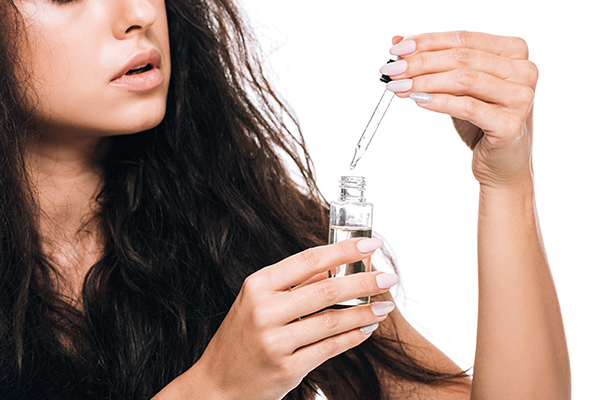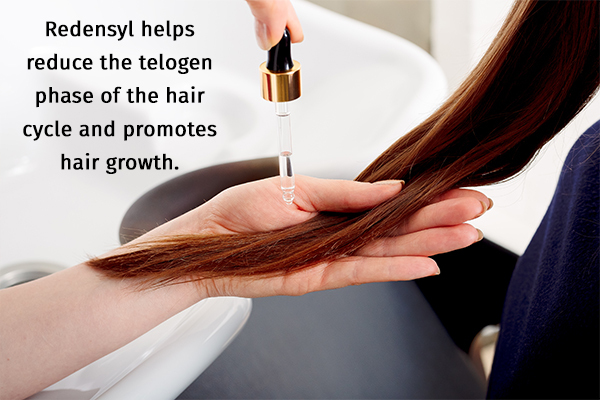In this article:
Hair loss is one of the most common hair-related complaints that affects almost half of the global population in varying degrees. Poor diets, (1) chemical hair treatments, (2) thyroid disorders, (3) COVID-19 infection, (4) environmental pollutants, and hereditary factors all contribute to this phenomenon.

Although hair loss is mainly a cosmetic issue with no serious health implications, it can be very distressing for some people.
Hair regrowth is tricky and requires a lot of time and patience. Thus, the pharmaceutical industry is constantly trying to come up with better solutions for hair loss and balding.
Redensyl is one such new-age innovation for the treatment of hair loss. It has been shown to be very effective for hair regrowth and gives results in a short period.
What Is Redensyl?
Redensyl is an active cosmetic ingredient developed by Indochem Laboratories (8) that essentially contains DHQG (dihydroquercetin-glucoside).
DHQG is a modified polyphenol derived from the larch tree. (9) It acts on the stem cells, or outer root sheath cells (ORSC) present in hair follicles to trigger their proliferation or division. (10) These stem cells play a crucial role in hair growth (11) as they kick-start the anagen phase (growth phase) of the hair growth cycle wherein each strand grows to its full length.
Thus, Redensyl stimulates the hair follicles to build hair. As it is water-soluble, Redensyl can be easily incorporated into oils, hair packs, and hair sprays for convenient use.
Redensyl Ingredients

Redensyl is a combination of 7 different compounds, (12) namely:
- DHQG (dihydroquercetin-glucoside)
- EGCG2 (epigallocatechin gallate-glucoside): EGCG2 is an anti-inflammatory and antioxidant compound (13) that can be beneficial for your scalp.
- Glycine: Glycine is an amino acid and is a major component of hair cells. Glycine is a major component of specific hair proteins called keratin associated proteins (KAP). (14)
- Zinc chloride: Zinc is known to promote hair growth. (12)
- Metabisulfite: Metabisulfite has antioxidant and antibacterial properties (15) that can be beneficial for the scalp.
- Glycerin: Glycerin helps lock moisture in your hair strands and make them softer.
- Water: Proper hydration of your hair strands and hair follicles is necessary for healthy hair.
Redensyl Side Effects
In clinical trials, Redensyl has not been known to cause any side effects, but most of this research has been undertaken by Indochem alone. Therefore, there is a need for more large-scale independent studies that could corroborate these findings and objectively confirm the safety of this product.
That said, it has been found that combining Redensyl with Minoxidil treatment may cause some side effects. So, it is important to consult your dermatologist before starting any hair treatment to understand the proper dosage and directions of use.
Redensyl Benefits
Redensyl offers the following benefits:
- Redensyl accelerates hair growth: Redensyl is a potent remedy for hair loss as it promotes hair growth in the hair follicles. The major components in this medication, DHQG, and EGCG2 activate hair regeneration and decrease hair loss in the telogen phase.
- Redensyl strengthens and thickens hair: Redensyl may also help increase blood flow to your hair and thus makes them stronger. It contains Keratin Associated Proteins that help make your hair glossier and more robust.
How to Use Redensyl?
The safe and proper way to apply Redensyl:
Note: Redensyl should never be used directly on your scalp or hair, as it is too harsh at its original potency.
- Oil: Massage a little bit of Redensyl based oil on your scalp for 5 minutes and let it rest overnight. Wash off with a mild shampoo in the morning.
- Serum: It is best to use Redensyl based serum after a shower. Take a few drops of the serum and massage it onto your scalp for 5 minutes. For best results, apply it before going to bed and leave it on overnight.
Redensyl vs. Minoxidil for Hair

Minoxidil is a well-known drug used in the treatment of hair loss. It is a vasodilator and works by increasing blood circulation to the hair follicles. It also induces the anagen (growth) phase of the hair growth cycle in hair follicles. (16)
Although Redensyl and Minoxidil are both effective treatments for hair loss, there are a few key differences in their usage and effectiveness:
- Redensyl is relatively safe to use without any known side effects and is therefore sold over-the-counter. Minoxidil oral, on the other hand, cannot be used without a doctor’s prescription in the US and is known to cause adverse side effects for some people. (17) However Minoxidil topical is available without prescription in the US.
- Redensyl can be used to reverse hair loss in its early stages but may not be as effective for severe forms of alopecia. Minoxidil is the most commonly used topical treatment for alopecia as it is highly effective.
- Redensyl can be used for a certain amount of time and stopped without any negative effect on your hair. Minoxidil should not be discontinued without your doctor’s approval. Doing so may result in rebound hair fall. (18)
ALSO READ: Redensyl vs Minoxidil: Key Differences to Help You Choose
How Long Does Redensyl Take to Show Results?

It usually takes at least 2 months of treatment to notice any significant improvement in your hair. If you have a more severe form of hair loss, it may take up to 6 months for Redensyl use to have an effect on your condition.
Know More About the Hair Growth Cycle
Before you use Redensyl, do look at the process of hair growth to understand how Redensyl works.
The average human scalp has more than 100,000 hair strands that arise from different hair follicles. There are several arteries present underneath the scalp’s surface that provide necessary nutrients to the follicles for hair growth. (5) All the hair on your head grows and falls at different rates.
Hair goes through three different stages of growth, known as the hair growth cycle. (6) At any given time, all the hair strands on your head are in different stages of this cycle.

- The anagen phase: Also called the growth phase, the anagen phase is the first phase of the hair growth cycle. In this phase, the hair follicle gives rise to a new hair strand that increases in length. The growth phase lasts for almost 2 to 6 years, and most of the hair on your scalp is in this phase.
- The catagen phase: This is the second phase of hair growth where the hair strand stops growing and forms a distinct separation from its follicle. The catagen phase usually lasts for only ten days before the hair enters the next stage.
- The telogen stage is known as the rest stage of the hair growth cycle. In this stage, the resting hair strand will remain on your scalp till the anagen phase is activated and it is pushed out by a new hair shaft. (7) This phase lasts for around 3 months – at the end of which the hair falls out. It is normal to lose up to 50–100 strands of hair per day. At the end of this 3- to 4-month phase, some of your hair falls out. Losing up to 100 hairs a day is normal. When a hair falls out, a new hair is grown in the same hair follicle, and the growing cycle begins again.
Redensyl helps reduce the telogen phase of the hair cycle and promotes hair growth. Redensyl is available in many formulations but is most commonly used as a serum or oil. It is an efficient and affordable treatment for your hair woes.
Final Word
Redensyl is a major breakthrough in the study of hair growth and is cited as a potential treatment for alopecia. In fact, its manufacturers claim that Redensyl may well be a non-invasive alternative to hair transplants, and have even backed such claims with their research findings.
However, more independent trials need to be conducted to conclusively establish the efficacy of this compound and rule out any possible side effects. If you are suffering from hair loss or baldness, it may be worth asking your doctor if you can try Redensyl therapy.
Redensyl is available as an over-the-counter treatment but it is best to consult a dermatologist for proper guidance before using it.
- Was this article helpful?
- YES, THANKS!NOT REALLY


